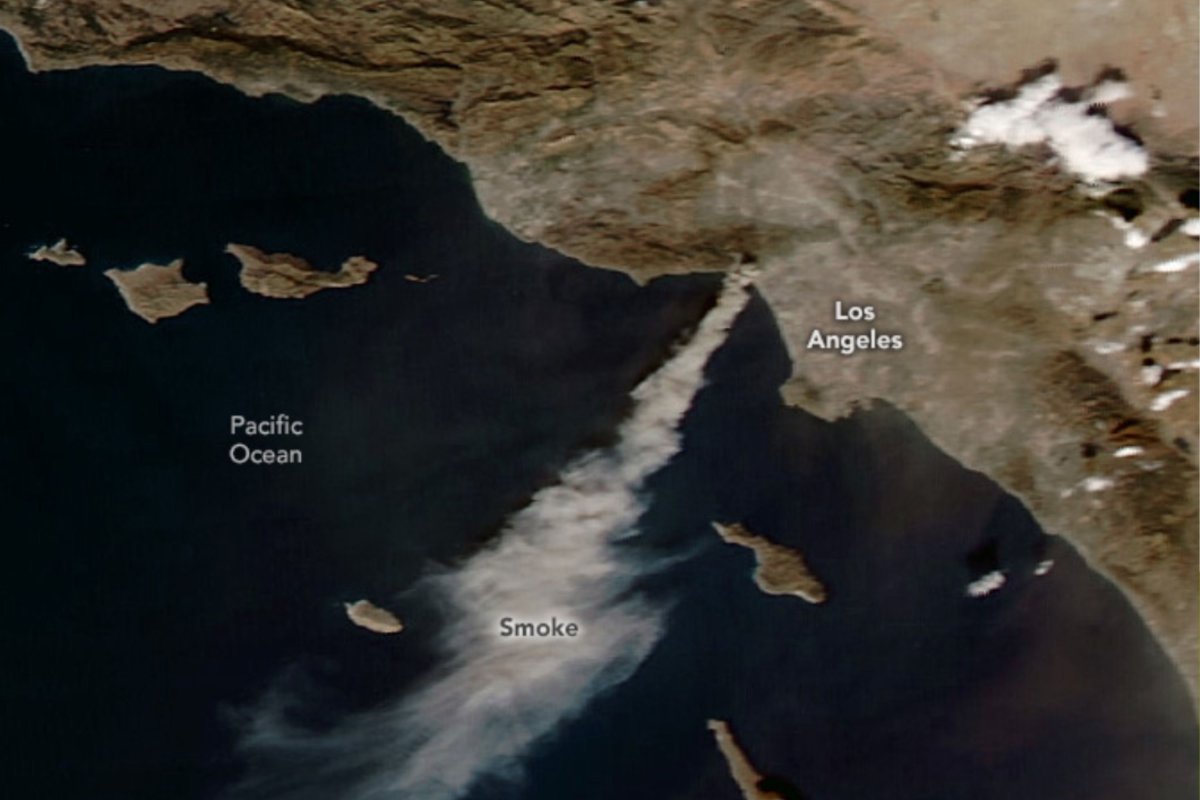With Los Angeles in the grips of several brutal wildfires which have decimated thousands of buildings and killed five people, a NASA satellite has snapped images of the huge volumes of smoke pouring from the blazes.
On January 7, as the Palisades fire, Eaton fire and Hurst fire started and began to spread, the MODIS (Moderate Resolution Imaging Spectroradiometer) instrument on NASA's Aqua satellite captured an image of thick grey smoke billowing from the city, blowing southwest over the ocean.
This thick smoke has caused a huge spike in air pollution across the region, with some areas reporting "hazardous" levels exceeding 500 on the Air Quality Index (AQI).

The largest of the fires is the Palisades fire, which has been burning in the Pacific Palisades since the morning of January 7. This blaze has now reached 17,234 acres in area as of 11 p.m. local time, and is now considered the most destructive fire in Los Angeles city history, having destroyed as much as 75 percent of the Pacific Palisades neighborhood, according to ABC7.
The homes of several celebrities were among the 1,000-strong structures that the fire has destroyed thus far, including those of Paris Hilton, Billy Crystal, as well as Adam Brody and Leighton Meester.
The Eaton fire, near Altadena, also started burning on January 7 and has since reached 10,600 acres in size. This blaze is responsible for all five of the deaths reported thus far, and has also resulted in the loss of around 1,000 structures.
Air quality in the area surrounding this fire has spiked over 900 on the AQI scale, due to the thick smoke pollution.
The Hurst fire in the San Fernando Valley also began on January 7, and has reached 855 acres, while the Lidia fire near Acton, which started burning on Wednesday has reached 348 acres. The Sunset fire, burning in the Hollywood Hills, only started yesterday evening, and has already expanded to 43 acres, according to CAL FIRE.
Over 100,000 people have been forced to evacuate across the city due to the "immediate threat to life" amid the blazes, and thousands of firefighters are currently battling the flames. The Palisades, Eaton and Sunset fires remain 0 percent contained, but the Hurst fire is now 10 percent contained, and the Lidia fire is 40 percent contained.
Other images snapped from space by the GOES-18 satellite reveal the glow of the flames' intense heat on January 8, as the blazes continued to scorch the city.
"Firefighters are working aggressively to slow the spread and protect critical infrastructure under extreme conditions," CAL FIRE said in a status update for the Eaton fire on Wednesday evening.
"Red Flag high wind conditions are expected to continue until Thursday evening. The combination of low humidity, dry fuels, and shifting winds has heightened the potential for spot fires and rapid expansion."
The cause of these fires remains unknown, however, their rapid spread has been aided by the dry vegetation following a low-precipitation winter and the powerful Santa Ana winds currently gusting through Southern California.
"A prolonged period of unusually low rainfall, coupled with the arid Santa Ana winds blowing in from inland areas, has created the perfect conditions for disaster: bone-dry vegetation that ignites easily in the parched, low-humidity environment, fueling rapidly spreading wildfires," Kimberley Simpson, a fellow in nature-based climate solutions at the University of Sheffield's School of Biosciences, said in a statement.
Santa Ana winds will restrengthen Thursday and last into Friday for inland areas. Slightly weaker than Wednesday for areas north of San Diego County. Slightly stronger than Wednesday for San Diego County. Critical fire weather conditions are expected! pic.twitter.com/7MdME6vsEn
— NWS San Diego (@NWSSanDiego) January 8, 2025As the planet warms, drought conditions may become more and more common in regions like California, resulting in more frequent occurrences of weather like this, which is primed for wildfires like these.
"Climate change has already made fire weather more extreme nearly everywhere around the world and especially so in the western USA. This means longer and more extreme fire seasons," Stefan Doerr, director of the Centre for Wildfire Research at Swansea University, told Newsweek.
Unfortunately, the high winds are not expected to abate any time soon, with wind gusts up to 70 mph forecast through Friday. The National Weather Service (NWS) has issued Red Flag Warnings for fire, as well as High Wind Watches and Wind Advisories.
"If fire ignition occurs, conditions are favorable for very rapid fire spread and extreme fire behavior, including long range spotting, which would threaten life and property," the NWS said in a statement.
Do you have a tip on a science story that Newsweek should be covering? Do you have a question about fire? Let us know via science@newsweek.com.




















 English (US) ·
English (US) ·